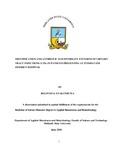Please use this identifier to cite or link to this item:
https://cris.library.msu.ac.zw//handle/11408/3914Full metadata record
| DC Field | Value | Language |
|---|---|---|
| dc.contributor.author | Nyakunhuwa, Beloved S. | - |
| dc.date.accessioned | 2020-12-01T10:00:54Z | - |
| dc.date.available | 2020-12-01T10:00:54Z | - |
| dc.date.issued | 2018-06 | - |
| dc.identifier.uri | http://hdl.handle.net/11408/3914 | - |
| dc.description.abstract | Urinary tract infections (UTIs) are the most common type of infections encountered in medical practice today. Effective treatment of these infections is being hindered by antibiotic resistance of UTI pathogens. Prevalence of UTIs differs with geographical location, seasons, and gender. Therefore, it is important to isolate and identify the uro-pathogens causing UTIs in an area and determine their antibiotic susceptibility patterns. In this study, a total of 92 mid-stream urine samples from patients who were presenting at the Zvishavane District Hospital (ZDH), were examined for UTIs using standard microbiological techniques during the period May 2017January 2018. Of the 92 samples examined 12 (13%), comprising nine from females and three from males, were infected with UTIs. Escherichia coli was the most prevalent uro-pathogen isolated comprising 58% of the isolates, followed by Klebsiella spp (17%) while three other isolates, S. saprophyticus, S. aureus, and P.aeruginosa had the same prevalence of 8%. Chloramphenicol was the most effective antibiotic being effective against 10 out of the 12 (83%) isolated uro-pathogens, followed by Gentamicin which was effective against 8 out of 12 (67%). Fusidic acid was the least effective antibiotic because all isolates (100%) were resistant to it. Only 2 out of 12 isolates were sensitive to Nalidixic acid. Five out of 12 isolates were resistant to the drug combination of Nalidixic acid and Fusidic acid, (resistant pattern or antibiotype Nalidixic AcidR Fusidic AcidR), suggesting that, this treatment combination should not be prescribed for UTIs. Chloramphenicol and Gentamicin were equally effective against most isolates because there was no significant difference in the proportion of the isolates that were sensitive to both of them (Chisquare, p = 0.001). The take home message from this study is that the most common UTIcausing pathogen in patients presenting at ZDH was E. coli and most pathogens were resistant to Nalidixic acid and Fusidic acid but sensitive to Gentamicin and Chloramphenicol. Therefore, Gentamicin and Chloramphenicol are recommended for UTIs treatment. A relatively low prevalence of 13% suggests that UTIs are not a risk to the residents of Zvishavane. | en_US |
| dc.language.iso | en | en_US |
| dc.publisher | Midlands State University | en_US |
| dc.subject | antibiotic Susceptibility patterns | en_US |
| dc.subject | urinary tract infections | en_US |
| dc.subject | identifications | en_US |
| dc.title | Identifications and antibiotic Susceptibility patterns of Urinary Tract infections in patients presenting at the Zvishavane District Hospital | en_US |
| dc.type | Thesis | en_US |
| item.languageiso639-1 | en | - |
| item.openairecristype | http://purl.org/coar/resource_type/c_18cf | - |
| item.grantfulltext | open | - |
| item.fulltext | With Fulltext | - |
| item.openairetype | Thesis | - |
| item.cerifentitytype | Publications | - |
| Appears in Collections: | Bachelor Of Science In Applied Biosciences And Biotechnology Honours Degree | |
Files in This Item:
| File | Description | Size | Format | |
|---|---|---|---|---|
| nyakunhuwa.pdf | Full Text | 1.14 MB | Adobe PDF |  View/Open |
Page view(s)
148
checked on Apr 5, 2025
Download(s)
116
checked on Apr 5, 2025
Google ScholarTM
Check
Items in MSUIR are protected by copyright, with all rights reserved, unless otherwise indicated.



